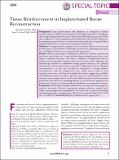| dc.contributor.author | Scheflan, Michael | en_US |
| dc.contributor.author | Colwell, Amy S. | en_US |
| dc.date.accessioned | 2014-12-02T21:28:50Z | |
| dc.date.issued | 2014 | en_US |
| dc.identifier.citation | Scheflan, Michael, and Amy S. Colwell. 2014. “Tissue Reinforcement in Implant-based Breast Reconstruction.” Plastic and Reconstructive Surgery Global Open 2 (8): e192. doi:10.1097/GOX.0000000000000140. http://dx.doi.org/10.1097/GOX.0000000000000140. | en |
| dc.identifier.issn | 2169-7574 | en |
| dc.identifier.uri | http://nrs.harvard.edu/urn-3:HUL.InstRepos:13454789 | |
| dc.description.abstract | Background: Tissue reinforcement with allogeneic or xenogeneic acellular dermal matrices (ADMs) is increasingly used in single-stage (direct-to-implant) and 2-stage implant-based breast reconstruction following mastectomy. ADMs allow surgeons to control implant position and obviate the need for submuscular implant placement. Here, we review the benefits and risks of using ADMs in implant-based breast reconstruction based on available data. Methods: A comprehensive analysis of the literature with focus on recent publications was performed. Additional information regarding the proper use of ADMs was based on our institutional experience. Results: ADM use may improve definition of the lateral confines of the breast and lower pole projection. It may facilitate direct-to-implant procedures and improve aesthetic outcomes. The effect of ADMs on complication rates remains controversial. Known patient risk factors such as obesity, smoking, and radiotherapy should be considered during patient selection. For patients with healthy, well-vascularized skin envelopes, ADM-assisted direct-to- implant reconstruction is a safe and cost-effective alternative to 2-stage implant reconstruction, with low complication rates. ADMs may be used to treat capsular contracture, and limited available data further suggest the possibility that ADMs may reduce the risk of capsular contracture. Novel synthetic or biosynthetic tissue reinforcement devices with different physical and ease-of-use properties than ADMs are emerging options for reconstructive surgeons and patients who seek to avoid tissue products from human or mammalian cadavers. Conclusions: ADM-assisted implant-based breast reconstruction may improve aesthetic outcomes. However, appropriate patient selection, surgical technique, and postoperative management are critical for its success, including minimizing the risk of complications. | en |
| dc.language.iso | en_US | en |
| dc.publisher | Wolters Kluwer Health | en |
| dc.relation.isversionof | doi:10.1097/GOX.0000000000000140 | en |
| dc.relation.hasversion | http://www.ncbi.nlm.nih.gov/pmc/articles/PMC4236353/pdf/ | en |
| dash.license | LAA | en_US |
| dc.title | Tissue Reinforcement in Implant-based Breast Reconstruction | en |
| dc.type | Journal Article | en_US |
| dc.description.version | Version of Record | en |
| dc.relation.journal | Plastic and Reconstructive Surgery Global Open | en |
| dash.depositing.author | Colwell, Amy S. | en_US |
| dc.date.available | 2014-12-02T21:28:50Z | |
| dc.identifier.doi | 10.1097/GOX.0000000000000140 | * |
| dash.contributor.affiliated | Colwell, Amy | |


